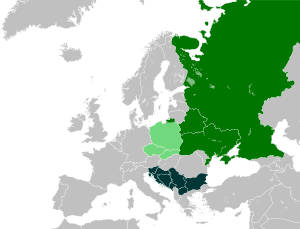South Slavs
The South Slavs are a subgroup of Slavic peoples who speak the South Slavic languages. They inhabit a contiguous region in the Balkan Peninsula and the eastern Alps, and in the modern era are geographically separated from the body of West Slavic and East Slavic people by the Romanians, Hungarians, and Austrians in between. The South Slavs today include the nations of Bosniaks, Bulgarians, Croats, Macedonians, Montenegrins, Serbs and Slovenes. They are the main population of the Eastern and Southeastern European countries of Bosnia and Herzegovina, Bulgaria, Croatia, Montenegro, North Macedonia, Serbia and Slovenia.
 South Slavic countries West and East Slavic countries | |
| Total population | |
|---|---|
| c. 30 million[1] | |
| Regions with significant populations | |
| Bosnia and Herzegovina, Bulgaria, Croatia, Montenegro, North Macedonia, Serbia, Slovenia | |
| Languages | |
| East South Slavic languages: Bulgarian Macedonian West South Slavic languages: Serbo-Croatian (Serbian, Croatian, Bosnian, Montenegrin) Slovene | |
| Religion | |
| Orthodox Christianity (Bulgarians, Macedonians, Montenegrins and Serbs) Roman Catholicism (Croats and Slovenes) Islam (Bosniaks, Pomaks, Gorani and Torbeši) | |
| Related ethnic groups | |
| Other Slavs |
In the 20th century, the country of Yugoslavia (literally "South Slavia" or "Southern Slavland") united the regions inhabited by South Slavic nations—with the key exception of Bulgaria—into a single state. The concept of Yugoslavia, a single state for all South Slavic peoples, emerged in the late 17th century and gained prominence through the 19th-century Illyrian movement. The Kingdom of Serbs, Croats and Slovenes, renamed the Kingdom of Yugoslavia in 1929, was proclaimed on 1 December 1918, following the unification of the State of Slovenes, Croats and Serbs with the kingdoms of Serbia and Montenegro.
Terminology
The South Slavs are known in Serbian, Macedonian and Montenegrin as Južni Sloveni (Cyrillic: Јужни Словени); in Bulgarian as Yuzhni Slavyani (Cyrillic: Южни славяни); in Croatian and Bosnian as Južni Slaveni; in Slovene as Južni Slovani. The Slavic root *jugъ means "south". The Slavic ethnonym itself was used by 6th-century writers to describe the southern group of Early Slavs (the Sclaveni); West Slavs were called Veneti and East Slavs Antes.[2] The South Slavs are also called "Balkan Slavs",[3] although this term does not encompass the Slovenes.
Another name popular in the early modern period was "Illyrians", the name of a pre-Slavic Balkan people, a name first adopted by Dalmatian intellectuals in the late 15th century to refer to South Slavic lands and population.[4] It was then used by the Habsburg Monarchy, France, and notably adopted by the 19th-century Croatian nationalist and Pan-Slavist Illyrian movement.[5] Eventually, the idea of Yugoslavism appeared, aimed at uniting all South Slav-populated territories into a common state. From this idea emerged Yugoslavia, which however did not include Bulgaria.
History
Early South Slavs
The Proto-Slavic homeland is the area of Slavic settlement in Central and Eastern Europe during the first millennium AD, with its precise location debated by archaeologists, ethnographers and historians.[6] None of the proposed homelands reaches the Volga River in the east, over the Dinaric Alps in the southwest or the Balkan Mountains in the south, or past Bohemia in the west.[7] Traditionally, scholars put it in the marshes of Ukraine, or alternatively between the Bug and the Dnieper;[8] however, according to F. Curta, the homeland of the southern Slavs mentioned by 6th-century writers was just north of the Lower Danube.[9] Little is known about the Slavs before the 5th century, when they began to spread out in all directions.
Jordanes, Procopius and other late Roman authors provide the probable earliest references to southern Slavs in the second half of the 6th century.[10] Procopius described the Sclaveni and Antes as two barbarian peoples with the same institutions and customs since ancient times, not ruled by a single leader but living under democracy,[11] while Pseudo-Maurice called them a numerous people, undisciplined, unorganized and leaderless, who did not allow enslavement and conquest, and resistant to hardship, bearing all weathers.[12] They were portrayed by Procopius as unusually tall and strong, of dark skin and "reddish" hair (neither blond nor black), leading a primitive life and living in scattered huts, often changing their residence.[13] Procopius said they were henotheistic, believing in the god of lightning (Perun), the ruler of all, to whom they sacrificed cattle.[13] They went into battle on foot, charging straight at their enemy, armed with spears and small shields, but they did not wear armour.[13]
While archaeological evidence for a large-scale migration is lacking, most present-day historians claim that Slavs invaded and settled the Balkans in the 6th and 7th centuries.[14] According to this dominant narrative, up until the late 560s their main activity across the Danube was raiding, though with limited Slavic settlement mainly through Byzantine colonies of foederati.[15] The Danube and Sava frontier was overwhelmed by large-scale Slavic settlement in the late 6th and early 7th century.[16] What is today central Serbia was an important geo-strategical province, through which the Via Militaris crossed.[17] This area was frequently intruded upon by barbarians in the 5th and 6th centuries.[17] From the Danube, the Slavs commenced raiding the Byzantine Empire on an annual basis from the 520s, spreading destruction, taking loot and herds of cattle, seizing prisoners and taking fortresses. Often, the Byzantine Empire was stretched, defending its rich Asian provinces from Arabs, Persians and others. This meant that even numerically small, disorganised early Slavic raids were capable of causing much disruption, but could not capture the larger, fortified cities.[15] The first Slavic raid south of the Danube was recorded by Procopius, who mentions an attack of the Antes, "who dwell close to the Sclaveni", probably in 518.[18] Sclaveni are first mentioned in the context of the military policy on the Danube frontier of Byzantine Emperor Justinian I (r. 527–565).[19] Throughout the century, Slavs raided and plundered deep into the Balkans, from Dalmatia to Greece and Thrace, and were also at times recruited as mercenaries, fighting the Ostrogoths.[20] Justinian seems to have used the strategy of 'divide and conquer', and the Sclaveni and Antes are mentioned as fighting each other.[21] The Antes are last mentioned as anti-Byzantine belligerents in 545, and the Sclaveni continued to raid the Balkans.[22] In 558 the Avars arrived at the Black Sea steppe, and defeated the Antes between the Dnieper and Dniester.[23] The Avars subsequently allied themselves with the Sclaveni,[24] although there was an episode in which the Sclavene Daurentius (fl. 577–579), the first Slavic chieftain recorded by name, dismissed Avar suzerainty and retorted that "Others do not conquer our land, we conquer theirs [...] so it shall always be for us", and had the Avar envoys slain.[25] By the 580s, as the Slav communities on the Danube became larger and more organized, and as the Avars exerted their influence, raids became larger and resulted in permanent settlement. Most scholars consider the period of 581-584 as the beginning of large-scale Slavic settlement in the Balkans.[26] F. Curta points out that evidence of substantial Slavic presence does not appear before the 7th century and remains qualitatively different from the "Slavic culture" found north of the Danube.[27] In the mid-6th century, the Byzantines re-asserted their control of the Danube frontier, thereby reducing the economic value of Slavic raiding. This growing economic isolation, combined with external threats from the Avars and Byzantines, led to political and military mobilisation. Meanwhile, the itinerant form of agriculture (lacking crop rotation) may have encouraged micro-regional mobility. Seventh-century archaeological sites show earlier hamlet collections evolving into larger communities with differentiated zones for public feasts, craftmanship, etc.[28] It has been suggested that the Sclaveni were the ancestors of the Serbo-Croatian group while the Antes were that of the Bulgarian Slavs, with much mixture in the contact zones.[29][30] The diminished pre-Slavic inhabitants, also including also Romanized native peoples,[a] fled from the barbarian invasions and sought refuge inside fortified cities and islands, whilst others fled to remote mountains and forests and adopted a transhumant lifestyle.[31] The Romance speakers within the fortified Dalmatian city-states managed to retain their culture and language for a long time.[32] Meanwhile, the numerous Slavs mixed with and assimilated the descendants of the indigenous population.[33]
Subsequent information about Slavs' interaction with the Greeks and early Slavic states comes from the 10th-century De Administrando Imperio (DAI) by Emperor Constantine VII Porphyrogenitus, the 7th-century compilations of the Miracles of Saint Demetrius (MSD) and the History by Theophylact Simocatta. DAI mentions the beginnings of the Croatian, Serbian and Bulgarian states from the early 7th to the mid-10th century. MSD and Theophylact Simocatta mention the Slavic tribes in Thessaly and Macedonia at the beginning of the 7th century. The 9th-century Royal Frankish Annals (RFA) also mention Slavic tribes in contact with the Franks.
Middle Ages
By 700 AD, Slavs had settled in most of the Central and Southeast Europe, from Austria even down to the Peloponnese of Greece, and from the Adriatic to the Black Sea, with the exception of the coastal areas and certain mountainous regions of the Greek peninsula.[34] The Avars, who arrived in Europe in the late 550s and had a great impact in the Balkans, had from their base in the Carpathian plain, west of main Slavic settlements, asserted control over Slavic tribes with whom they besieged Roman cities. Their influence in the Balkans however diminished by the early 7th century and they were finally defeated and disappeared as a power at the turn of the 9th century by Bulgaria and the Frankish Empire.[35] The first South Slavic polity and regional power was Bulgaria, a state formed in 681 as a union between the much numerous Slavic tribes and the bulgars of Khan Asparuh. The scattered Slavs in Greece, the Sklavinia, were Hellenized.[36] Romance-speakers lived within the fortified Dalmatian city-states.[32] Traditional historiography, based on DAI, holds that the migration of Serbs and Croats to the Balkans was part of a second Slavic wave, placed during Heraclius' reign.[37]
Inhabiting the territory between the Franks in the north and Byzantium in the south, the Slavs were exposed to competing influences.[38] In 863 to Christianized Great Moravia were sent two Byzantine brothers monks Saints Cyril and Methodius, Slavs from Thessaloniki on missionary work. They created the Glagolitic script and the first Slavic written language, Old Church Slavonic, which they used to translate Biblical works. At the time, the West and South Slavs still spoke a similar language. The script used, Glagolitic, was capable of representing all Slavic sounds, however, it was gradually replaced in Bulgaria in the 9th century, in Russia by the 11th century[39] Glagolitic survived into the 16th century in Croatia, used by Benedictines and Franciscans, but lost importance during the Counter-Reformation when Latin replaced it on the Dalmatian coast.[40] Cyril and Methodius' disciples found refuge in already Christian Bulgaria, where the Old Church Slavonic became the ecclesiastical language.[40] Early Cyrillic alphabet was developed during the 9th century AD at the Preslav Literary School in Bulgaria.[41][42][43] The earliest Slavic literary works were composed in Bulgaria, Duklja and Dalmatia. The religious works were almost exclusively translations, from Latin (Croatia, Slovenia) and especially Greek (Bulgaria, Serbia).[40] In the 10th and 11th centuries the Old Church Slavonic leaded to the creation of various regional forms like Serbo-Croatian and Slovenian[40] Economic, religious and political centres of Ohrid and Plovdiv contributed to the important literary production in the Bulgarian Empire.[44] The Bogomil sect, derived from Manichaeism, was deemed heretical, but managed to spread from Bulgaria to Bosnia (where it gained a foothold).[45] and France (Cathars).
Carinthia came under Germanic rule in the 10th century and came permanently under Western (Roman) Christian sphere of influence.[46] What is today Croatia came under Eastern Roman (Byzantine) rule after the Barbarian age, and while most of the territory was Slavicized, a handful of fortified towns, with mixed population, remained under Byzantine authority and continued to use Latin.[46] Dalmatia, now applied to the narrow strip with Byzantine towns, came under the Patriarchate of Constantinople, while the Croatian state remained pagan until Christianization during the reign of Charlemagne, after which religious allegiance was to Rome.[46] Croats threw off Frankish rule in the 9th century, and took over the Byzantine Dalmatian towns, after which Hungarian conquest led to Hungarian suzerainty, although retaining an army and institutions.[47] Croatia lost much of Dalmatia to the Republic of Venice which held it until the 18th century.[48] Hungary governed Croatia through a duke, and the coastal towns through a ban.[48] A feudal class emerged in the Croatian hinterland in the late 13th century, among whom were the Kurjaković, Kačić and most notably the Šubić.[49] Dalmatian fortified towns meanwhile maintained autonomy, with a Roman patrician class and Slavic lower class, first under Hungary and then Venice after centuries of struggle.[50]
Ibn al-Faqih described two kinds of South Slavic people, the first of swarthy complexion and dark hair, living near the Adriatic coast, and the other as light, living in the hinterland.
Early modern period
After Ottoman expansion into Byzantine territories in the east in the first half of the 14th century, the internally divided Bulgarian Empire and the short-lived and crumbling Serbian Empire stood next. In 1371, the Ottomans defeated a large Serbian army at the Battle of Maritsa, and in 1389 defeated the Serbian army at the Battle of Kosovo. By now, Serbian and Bulgarian rulers became Ottoman vassals, the southern Serbian provinces and Bulgaria holding out until annexation in the 1390s. The Ottomans conquered Constantinople (1453), Greece (1453–60), the Serbian Despotate (1459) and Bosnia (1463). Much of the Balkans was under Ottoman rule throughout the early modern period. Ottoman rule lasted from the 14th into the early 20th century in some territories. Ottoman society was multi-ethnic and multi-religious, and confessional groups were divided according to the millet system, in which Orthodox Christians (Greeks, Bulgarians, Serbs, etc.) constituted the Rum Millet. In Islamic jurisprudence, the Christians had dhimmi status, which entailed certain taxes and lesser rights. Through Islamization, communities of Slavic Muslims emerged, which survive until today in Bosnia, south Serbia, North Macedonia, and Bulgaria.
In the 16th century, the Habsburg Monarchy controlled what is today Slovenia, Croatia and northern Serbia. The Kingdom of Croatia, which included smaller parts of what is today Croatia, was a crown land of the Habsburg emperor. The early modern period saw large-scale migrations of Orthodox Slavs (mainly Serbs) to the north and west. The Military Frontier was set up as the cordon sanitaire against Ottoman incursions. There were several rebellions against Ottoman rule, but it was not until the 18th century that parts of the Balkans, namely Serbia, were liberated for a longer period. While Pan-Slavism has its origins in the 17th-century Slavic Catholic clergymen in the Republic of Venice and Republic of Ragusa, it crystallized only in the mid-19th century amidst rise of nationalism in the Ottoman and Habsburg empires.
Statistics
| Countries | Bosnia and Herzegovina | Bulgaria | Croatia | Montenegro | North Macedonia | Serbia | Slovenia |
|---|---|---|---|---|---|---|---|
| Flag | |||||||
| Coat of arms | 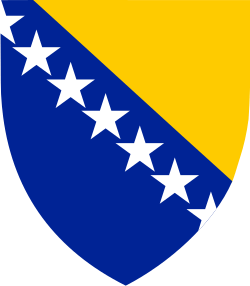 |
.svg.png) |
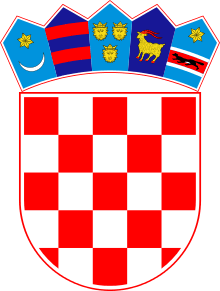 |
 |
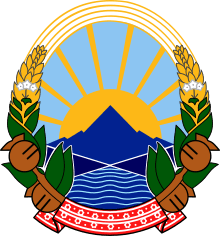 |
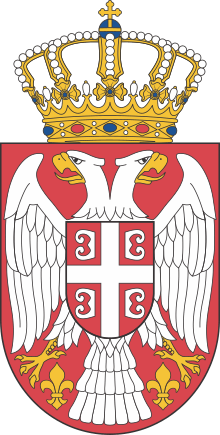 |
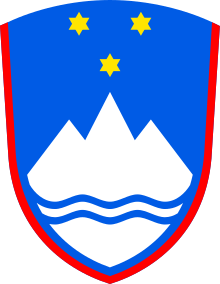 |
| Capital | Sarajevo | Sofia | Zagreb | Podgorica | Skopje | Belgrade | Ljubljana |
| Independence | March 1, 1992 |
October 5, 1908 |
June 25, 1991 |
June 3, 2006 |
September 8, 1991 |
July 13, 1878 |
June 25, 1991 |
| Current President | Šefik Džaferović | Rumen Radev | Zoran Milanović | Milo Đukanović | Stevo Pendarovski | Aleksandar Vučić | Borut Pahor |
| Current Prime Minister | Zoran Tegeltija | Boyko Borisov | Andrej Plenković | Duško Marković | Zoran Zaev | Ana Brnabić | Janez Janša |
| Population (2016) | 3,515,982 | 7,153,784 | 4,190,669 | 622,218 | 2,071,278 | 7,001,444 | 2,064,188 |
| Area | 51,197 km2 | 110,879 km2 | 56,594 km2 | 13,812 km2 | 25,713 km2 | 88,361 km km | 20,273 km2 |
| Density | 69/km2 | 65/km2 | 74/km2 | 45/km2 | 81/km2 | 91/km2 | 102/km2 |
| Water area % | 0.02% | 2.16% | 1.1% | 2.61% | 1.09% | 0.13% | 0.6% |
| GDP (nominal) total (2020) | $21.023 billion | $70.126 billion | $63.172 billion | $5.685 billion | $12.383 billion | $56.886 billion | $56.000 billion |
| GDP (PPP) per capita (2020) | $14,894 | $26,034 | $29,207 | $20,977 | $16,253 | $19,792 | $40,343 |
| Gini Index (2012[51]) | 33.8 | 36.0 | 32.0 | 33.2 | 43.2 | 29.7 | 25.6 |
| HDI (2018)[52] | 0.769 (High) | 0.816 (Very High) | 0.837 (Very High) | 0.816 (Very High) | 0.759 (High) | 0.799 (High) | 0.902 (Very High) |
| Internet TLD | .ba | .bg | .hr | .me | .mk | .rs | .si |
| Calling code | +387 | +359 | +385 | +382 | +389 | +381 | +386 |
Peoples and countries
South Slavs are divided linguistically into eastern (Bulgarian and Macedonian) and western groups (Slovenes, Croatian, Bosnian, Serbian, and Montenegrin), and religiously into Orthodox (Serbs, Bulgarians, Macedonians, Montenegrins), Catholic (Croats, Slovenes) and Muslim (Bosniaks, Pomaks, and other minorities). There are an estimated 35 million South Slavs and their descendants living worldwide. Among South Slavic ethnic groups that are also nations are the Serbs, Bulgarians, Croats, Bosniaks, Slovenes, Macedonians and Montenegrins. Bosniaks, Serbs and Croats are the constituent nations of Bosnia and Herzegovina. Among South Slavic minorities or self-identifications are the Yugoslavs (former Yugoslavia), Muslims (former Yugoslavia), Torbeshi (North Macedonia), Pomaks (Bulgaria, Greece) and Gorani (Kosovo). The Catholic Bunjevci and Šokci, concentrated in northern Serbia and eastern Croatia, are divided between Croat and local identities. There are also smaller communities of West and East Slavic peoples in northern Serbia.
- Countries
There are seven countries in which South Slavs are the main population:[53]
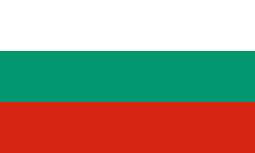
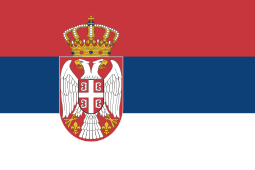
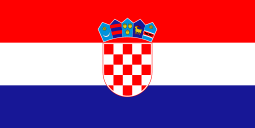
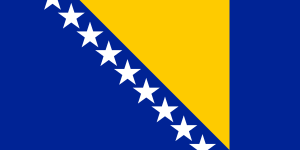
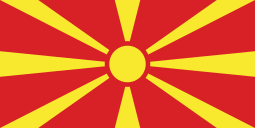
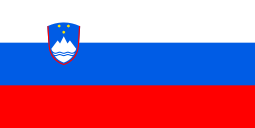
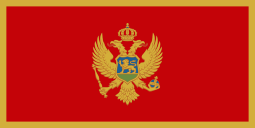
In addition, there are local South Slavic minorities in non-South Slavic neighbouring countries such as:
- Albania: (Bosniaks, Bulgarians, Macedonians, Serbs, Montenegrins)
- Austria: (Croats, Slovenes)*
- Greece: (Slavic-speakers of Greek Macedonia, Pomaks)
- Hungary: (Bulgarians, Croats, Slovenes and Serbs)
- Italy: (Slovenes, Croats, Serbs)
- Kosovo: (Serbs, Bosniaks)
- Moldova: (Bulgarians)
- Romania: (Croats, Bulgarians, Serbs, Macedonians)
- Slovakia: (Serbs)
- Turkey: (Bulgarians, Bosniaks, Montenegrins, Macedonians, Pomaks)
- Ukraine: (Bulgarians)
Cities
Religion
The religious and cultural diversity of the region the South Slavs inhabit has had a considerable influence on their religion. Originally a polytheistic pagan people, the South Slavs have also preserved many of their ancient rituals and traditional folklore, often intermixing and combining it with the religions they later converted to.
Today, the majority of South Slavs are Orthodox Christians; this includes most Bulgarians, Macedonians, Serbs and Montenegrins. Most Slovenes and Croats are Roman Catholics. Bosniaks and other minor ethnic groups (Gorani, Muslims by nationality) and sub-groups (Torbesh and Pomaks) are Muslims. Some South Slavs are atheist, agnostic and/or non-religious.
Orthodoxy
|
Catholicism
|
Islam
|
Languages
The South Slavic languages, one of three branches of the Slavic languages family (the other being West Slavic and East Slavic), form a dialect continuum. It comprises, from west to east, the official languages of Slovenia, Croatia, Bosnia and Herzegovina, Montenegro, Serbia, North Macedonia, and Bulgaria. The South Slavic languages are geographically divided from the rest of the Slavic languages by areas where Germanic (Austria), Hungarian and Romanian languages prevail.
South Slavic standard languages are:
|
West: |
East:
|
The Serbo-Croatian varieties have strong structural unity and are regarded by most linguists as constituting one language.[55] Today, language secessionism has led to the codification of several distinct standards: Serbian, Croatian, Bosnian and Montenegrin. Bosnian was officially established in 1996. These Serbo-Croatian standards are all based on the Shtokavian dialect group. Other dialect groups, which have lower intelligibility with Shtokavian, are Chakavian in Dalmatia and Kajkavian in Croatia proper. The dominance of Shtokavian across Serbo-Croatian speaking lands is due to historical westward migration during the Ottoman period. Slovene is South Slavic but has many features shared with West Slavic languages. The Prekmurje Slovene and Kajkavian are especially close, and there is no sharp delineation between them. In southeastern Serbia, dialects enter a transitional zone with Bulgarian and Macedonian, with features of both groups, and are commonly called Torlakian.
The Eastern South Slavic languages are Bulgarian and Macedonian. Bulgarian has retained more archaic Slavic features in relation to the other languages. Bulgarian has two main yat splits. Slavic Macedonian was codified in Communist Yugoslavia in 1945 and was historically classified as Bulgarian. The Macedonian dialects, divided into three main groups, are regarded overall as being transitional to Bulgarian and Serbo-Croatian. The westernmost Bulgarian dialects (called Shopi) share features with Serbo-Croatian. Furthermore, in Greece there is a notable Slavic-speaking population in Greek Macedonia and western Thrace.
Balkan Slavic languages are part of a "Balkan sprachbund" with areal features shared with other non-Slavic languages in the Balkans.
Genetics
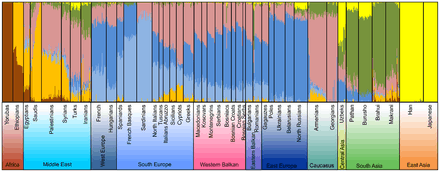
The earliest genetic studies for population affinities were according to 'classical markers', i.e. protein and blood group polymorphisms, according to which Cavalli-Sforza's team suggested several European cluster groups: "Germanic", "Scandinavian", "Celtic", south-western European and eastern European. The Yugoslavs (Bulgarians were not tested) did not group into any of the above but formed a group of their own, attributed to internal heterogeneity.
According to a 2006 Y-DNA study, most South Slavs clustered together, while western Croats and Slovenians were instead clustered with West and East Slavic populations. Southern-Slavic populations (Serbs, Bosnians, Macedonians, and northern Croats) are genetically distinct from their northern linguistic relatives.[56] A 2008 study concluded that except for some isolated communities, Europeans are somewhat genetically homogeneous, and individual population groups are often closely related to their immediate neighbours (irrespective of language or ethnicity).[57][58] A study of 90 samples showed that former Yugoslav populations had a genetic uniformity, intermediate between South Europe and Eastern Europe, in line with their geographic location.[59] Based on analysis of IBD sharing, Middle Eastern populations most likely did not contribute to genetics in Islamicized populations in the former Yugoslavia, as these share similar patterns with Christians.[59]
See also
| Wikimedia Commons has media related to South Slavs. |
Annotations
- ^ Prior to the advent of Roman rule, a number of native or autochthonous populations had lived in the Balkans since ancient times. South of the Jireček line were the Greeks. To the north, there were Illyrians, Thracians and Dacians. They were mainly tribalistic and generally lacked awareness of any ethno-political affiliation. Over the classical ages, they were at times invaded, conquered and influenced by Celts, ancient Greeks and ancient Romans. Roman influence, however, was initially limited to cities concentrated along the Dalmatian coast, later spreading to a few scattered cities inside the Balkan interior, particularly along the river Danube (Sirmium, Belgrade, Niš). Roman citizens from throughout the empire settled in these cities and in the adjacent countryside. Following the fall of Rome and numerous barbarian raids, the population in the Balkans dropped, as did commerce and general standards of living. Many people were killed or taken prisoner by invaders. This demographic decline was particularly attributed to a drop in the number of indigenous peasants living in rural areas. They were the most vulnerable to raids and were also hardest hit by the financial crises that plagued the falling empire. However, the Balkans were not desolate, and considerable numbers of indigenous people remained. Only certain areas tended to be affected by the raids (e.g. lands around major land routes, such as the Morava corridor).[60] In addition to the autochthons, there were remnants of previous invaders such as "Huns" and various Germanic peoples when the Slavs arrived. Sarmatian tribes such as the Iazyges were still recorded as living in the Banat region of the Danube.[61] The mixing of Slavs and other peoples is evident in genetic studies included in the article.
References
- South Slavs
- Kmietowicz 1976.
- Kmietowicz 1976, Vlasto 1970
- URI 2000, p. 104.
- Hupchick 2004, p. 199.
- Kobyliński 2005, pp. 525–526, Barford 2001, p. 37
- Kobyliński 2005, p. 526, Barford 2001, p. 332
- Fine 1991, p. 25.
- Curta 2006, p. 56.
- Curta 2001, pp. 71–73.
- James 2014, p. 95, Kobyliński 1995, p. 524
- Kobyliński 1995, pp. 524–525.
- Kobyliński 1995, p. 524.
- Fine 1991, pp. 26–41.
- Fine 1991, p. 29.
- Fine 1991, p. 33.
- Živković 2002, p. 187.
- James 2014, p. 95, Curta 2001, p. 75
- Curta 2001, p. 76.
- Curta 2001, pp. 78–86.
- James 2014, p. 97.
- Byzantinoslavica. 61–62. Academia. 2003. pp. 78–79.
- Kobyliński 1995, p. 536.
- Kobyliński 1995, p. 537–539.
- Curta 2001, pp. 47, 91.
- Fine 1991, p. 31.
- Curta 2001, p. 308.
- Curta 2007, p. 61.
- Hupchick 2004.
- Fine 1991, p. 26.
- Fine 1991, pp. 37.
- Fine 1991, p. 35.
- Fine 1991, pp. 38, 41.
- Fine 1991, p. 36.
- Fine 1991, pp. 29–43.
- Fine 1991, p. 41.
- Curta 2001, p. 66.
- Portal 1969, p. 90.
- Portal 1969, pp. 90–92.
- Portal 1969, p. 92.
- Dvornik, Francis (1956). The Slavs: Their Early History and Civilization. Boston: American Academy of Arts and Sciences. p. 179.
The Psalter and the Book of Prophets were adapted or "modernized" with special regard to their use in Bulgarian churches, and it was in this school that glagolitic writing was replaced by the so-called Cyrillic writing, which was more akin to the Greek uncial, simplified matters considerably and is still used by the Orthodox Slavs.
- Florin Curta (2006). Southeastern Europe in the Middle Ages, 500–1250. Cambridge Medieval Textbooks. Cambridge University Press. pp. 221–222. ISBN 978-0521815390.
Cyrillic preslav.
- J. M. Hussey, Andrew Louth (2010). "The Orthodox Church in the Byzantine Empire". Oxford History of the Christian Church. Oxford University Press. p. 100. ISBN 978-0191614880.
- Portal 1969, p. 93.
- Portal 1969, pp. 93–95.
- Portal 1969, p. 96.
- Portal 1969, p. 96–97.
- Portal 1969, p. 97.
- Portal 1969, p. 97–98.
- Portal 1969, p. 98.
- GINI index
- "2019 Human Development Report" (PDF). United Nations Development Programme. 2019. Retrieved 9 December 2019.
- "The World Factbook". cia.gov.
- Sarajevo, juni 2016. CENZUS OF POPULATION, HOUSEHOLDS AND DWELLINGS IN BOSNIA AND HERZEGOVINA, 2013 FINAL RESULTS (PDF). BHAS. Retrieved 30 June 2016.
- Comrie, Bernard & Corbett, Greville G., eds. (2002) [1st. Pub. 1993]. The Slavonic Languages. London & New York: Routledge. OCLC 49550401.
- Rebała, K; Mikulich, AI; Tsybovsky, IS; Siváková, D; Dzupinková, Z; Szczerkowska-Dobosz, A; Szczerkowska, Z (2007). "Y-STR variation among Slavs: Evidence for the Slavic homeland in the middle Dnieper basin". Journal of Human Genetics. 52 (5): 406–14. doi:10.1007/s10038-007-0125-6. PMID 17364156.
- Novembre, J; et al. (November 2008), "Genes mirror geography within Europe", Nature, 456 (7218): 98–101, Bibcode:2008Natur.456...98N, doi:10.1038/nature07331, PMC 2735096, PMID 18758442
- Lao O, Lu TT, Nothnagel M, et al. (August 2008), "Correlation between genetic and geographic structure in Europe", Curr. Biol., 18 (16): 1241–8, doi:10.1016/j.cub.2008.07.049, PMID 18691889
- Kovacevic, Lejla; Tambets, Kristiina; Ilumäe, Anne-Mai; Kushniarevich, Alena; Yunusbayev, Bayazit; Solnik, Anu; Bego, Tamer; Primorac, Dragan; Skaro, Vedrana (22 August 2014). "Standing at the Gateway to Europe - The Genetic Structure of Western Balkan Populations Based on Autosomal and Haploid Markers". PLOS ONE. 9 (8): e105090. Bibcode:2014PLoSO...9j5090K. doi:10.1371/journal.pone.0105090. ISSN 1932-6203. PMC 4141785. PMID 25148043.
- Fine 1991, pp. 9–12, 37.
- Fine 1991, p. 57.
Sources
- Primary sources
- Moravcsik, Gyula, ed. (1967) [1949]. Constantine Porphyrogenitus: De Administrando Imperio (2nd revised ed.). Washington D.C.: Dumbarton Oaks Center for Byzantine Studies. ISBN 9780884020219.
- Scholz, Bernhard Walter, ed. (1970). Carolingian Chronicles: Royal Frankish Annals and Nithard's Histories. University of Michigan Press. ISBN 0472061860.
- Books
- Barford, Paul M. (2001). The Early Slavs: Culture and Society in Early Medieval Eastern Europe. Ithaca, NY: Cornell University Press. ISBN 0801439779.
- Castellan, Georges (1992). History of the Balkans: From Mohammed the Conqueror to Stalin. East European Monographs. ISBN 978-0-88033-222-4.
- Curta, Florin (2001). The Making of the Slavs: History and Archaeology of the Lower Danube Region, c. 500–700. Cambridge: Cambridge University Press. ISBN 9781139428880.
- Curta, Florin (2006). Southeastern Europe in the Middle Ages, 500–1250. Cambridge: Cambridge University Press. ISBN 9780521815390.
- Dvornik, Francis (1962). The Slavs in European History and Civilization. New Brunswick: Rutgers University Press. ISBN 9780813507996.
- Fine, John Van Antwerp Jr. (1991) [1983]. The Early Medieval Balkans: A Critical Survey from the Sixth to the Late Twelfth Century. Ann Arbor, Michigan: University of Michigan Press. ISBN 0472081497.
- Fine, John Van Antwerp Jr. (1994) [1987]. The Late Medieval Balkans: A Critical Survey from the Late Twelfth Century to the Ottoman Conquest. Ann Arbor, Michigan: University of Michigan Press. ISBN 0472082604.
- Fine, John Van Antwerp Jr. (2005). When Ethnicity Did Not Matter in the Balkans: A Study of Identity in Pre-Nationalist Croatia, Dalmatia, and Slavonia in the Medieval and Early-Modern Periods. Ann Arbor, Michigan: University of Michigan Press. ISBN 0472025600.
- Hupchick, Dennis P. (2004) [2002]. The Balkans: From Constantinople to Communism. Palgrave Macmillan. ISBN 978-1-4039-6417-5.
- James, Edward (2014). Europe's Barbarians AD 200-600. Routledge. ISBN 978-1-317-86825-5.
- Janković, Đorđe (2004). "The Slavs in the 6th Century North Illyricum". Гласник Српског археолошког друштва. 20: 39–61.
- Jelavich, Barbara (1983a). History of the Balkans: Eighteenth and Nineteenth Centuries. 1. Cambridge University Press. ISBN 9780521274586.
- Jelavich, Barbara (1983b). History of the Balkans: Twentieth Century. 2. Cambridge University Press. ISBN 9780521274593.
- Kaimakamova, Miliana; Salamon, Maciej (2007). Byzantium, new peoples, new powers: the Byzantino-Slav contact zone, from the ninth to the fifteenth century. Towarzystwo Wydawnicze "Historia Iagellonica". ISBN 978-83-88737-83-1.
- Kmietowicz, Frank A. (1976). Ancient Slavs. Worzalla Publishing Company.
- Kobyliński, Zbigniew (1995). The Slavs. The New Cambridge Medieval History: Volume 1, C.500-c.700. Cambridge University Press. p. 524. ISBN 978-0-521-36291-7.
- Kobyliński, Zbigniew (2005). "The Slavs". In Fouracre, Paul (ed.). The New Cambridge Medieval History, Volume 1: c.500–c.700. Cambridge University Press. ISBN 978-0-521-36291-7.
- Obolensky, Dimitri (1974) [1971]. The Byzantine Commonwealth: Eastern Europe, 500-1453. London: Cardinal.
- Ostrogorsky, George (1956). History of the Byzantine State. Oxford: Basil Blackwell.
- Portal, Roger (1969) [1965]. The Slavs. Translated by Evans, Patrick (Translated from French ed.). Weidenfeld & Nicolson.
- Runciman, Steven (1930). A History of the First Bulgarian Empire. London: G. Bell & Sons.
- Samardžić, Radovan; Duškov, Milan, eds. (1993). Serbs in European Civilization. Belgrade: Nova, Serbian Academy of Sciences and Arts, Institute for Balkan Studies. ISBN 9788675830153.
- Singleton, Fred (1985). A Short History of the Yugoslav Peoples. Cambridge University Press. ISBN 978-0-521-27485-2.
- Stavrianos, Leften Stavros (2000). The Balkans Since 1453. C. Hurst & Co. Publishers. ISBN 978-1-85065-551-0.
- Vlasto, Alexis P. (1970). The Entry of the Slavs into Christendom: An Introduction to the Medieval History of the Slavs. Cambridge: Cambridge University Press. ISBN 9780521074599.
- Živković, Tibor (2002). Јужни Словени под византијском влашћу 600-1025 [South Slavs under the Byzantine Rule (600–1025)]. Belgrade: Историјски институт САНУ.
- Živković, Tibor (2008). Forging unity: The South Slavs between East and West 550-1150. Belgrade: The Institute of History, Čigoja štampa.
- Journals
- Gitelman, Zvi; Hajda, Lubomyr A.; Himka, John-Paul; Solchanyk, Roman, eds. (2000). Cultures and Nations of Central and Eastern Europe: Essays in Honor of Roman Szporluk. Ukrainian Research Institute, Harvard University. ISBN 978-0-916458-93-5.
Further reading
- Jelavich, C., 1990. South Slav nationalisms—textbooks and Yugoslav Union before 1914. Ohio State Univ Pr.
- Petkov, K., 1997. Infidels, Turks, and women: the South Slavs in the German mind; ca. 1400-1600. Lang.
- Ferjančić, B., 2009. Vizantija i južni Sloveni. Ethos.
- Kovacevic, M.G.J., 1950. Pregled materijalne kulture Juznih Slovena.
- Filipovic, M.S., 1963. Forms and functions of ritual kinship among South Slavs. In V Congres international des sciences anthropologiques et ethnologiques (pp. 77–80).
- Šarić, L., 2004. Balkan identity: Changing self-images of the South Slavs. Journal of Multilingual and Multicultural development, 25(5-6), pp. 389–407.
- Ostrogorsky, G., 1963. Byzantium and the South Slavs. The Slavonic and East European Review, 42(98), pp. 1–14.
